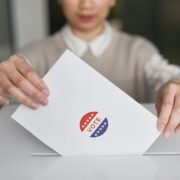AS elections officers and communities continue to process the results of the highly contentious 2022 midterm elections, one thing is clear: Asian American voters, especially those in Los Angeles County, have the potential to decide races.
According to local demographics, more than 639,000 voters identify as Asian American or Pacific Islander (AAPI) in LA County, which accounts for more than 11% of all LA County voters, which, according to Candice Cho, managing director of policy and counsel at AAPI Equity Alliance, which hosted a briefing discussing the impact of AAPI voters in 2022 and beyond.
The increase in vote-by-mail during the 2020 election contributed to the increase of voters, especially the Asian American electorate.
“We know that in 2020, almost three out of four Asian voters voted early or by mail, which is larger than any other [racial] community,” Christine Chen, executive director and co-founder of Asian Pacific Islander American (APIA) Vote, said in a recent press briefing.
Over the last few election cycles, outreach to AAPI voters has increased, especially in the wake of the Stop Asian Hate movement, which really ignited conversations on the diverse Asian communities that are often left out in national politics.
“Our communities, when reached out to, really show up. And I think that voting matters, but also making sure that the information that our communities get is accurate and clear is important,” said Nancy Yap, executive director for the Center for Asian Americans United for Self-Empowerment (CAUSE).
Chen mirrored Yap’s perspective, adding that with increased voter turnout among Asian voters, the issues that affect the broader AAPI community gain more attention among lawmakers.
“We are really relying on the API electorate to actually turn out because when you turn out, it increases our numbers. It gets us more attentional nationally, and then, that translates in terms of how effective we are in lobbying and advocating for our issues,” Chen said.
However, the methodology of data gathering and disaggregation of voters could be improved., and while organizations and coalitions like AAPI Equity Alliance promote research bodies (like APIAVote) that take Asian data disaggregation seriously, many government agencies’ methods for disaggregating data are outdated.
As previously reported in the Asian Journal, data disaggregation for the Asian community is either rudimentary or nonexistent, with either a few Asian groups getting their own dedicated outreach and studies or lumping every Asian community under one label. Experts in public policy and academia have argued that stronger and more detailed data disaggregation would help address many problems faced by individual cultural groups that are often lumped together under one overly broad label.
Currently, the California Office of the Secretary of State categorizes voters’ ethnicities and races by surname, which presents many problems for those in intercultural families, linguistic diversity of surnames, and other variables that make it difficult to determine ethnicity or race by someone’s name alone.
Godfrey Plata, a civic engagement consultant for the AAPI Equity Alliance, shared exit poll data from the California Office of Secretary of State — which found that Filipino voters were the second-largest Asian group at the polls this year — acknowledged the limitations data gathering.
“I’m Filipino, my last name is Plata, so I get [election materials] in Spanish, Tagalog, and English, so I don’t often know how my name is being estimated,” Plata said. “As an organizer, it’s important that we have questions like this that have substantive and material implications for our community and work in tandem so that we can figure out how to make things more honest and authentic and real for data collection.” (Klarize Medenilla/AJPress)






